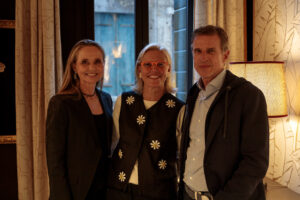On May 8th, the Humanitas360 Institute unveiled a groundbreaking Hemp-based installation at the opening reception of the 19th Venice Biennale of Architecture in Italy. The work, created in partnership with architects Pedro Mendes da Rocha and Chico Gitahy, along with the Ficus Institute, was specially conceived for “Biennale Architettura 2025” and marks the beginning of H360’s 10th anniversary celebrations. The event opened to the general public on May 10th and runs through November 23rd, 2025.
In the images below, our president Patrícia Villela Marino socializes with board member Ricardo Villela Marino and Brazilian ambassador to Rome, Renato Mosca de Souza, at the inauguration of the Brazilian pavilion at the Biennale; converses with entrepreneur and activist Philip Yang and Werner Schoenthaler from Hemp panel supplier Hanfstein; hosts Maguy Etlin and Antonio Lessa—respectively the president of the international advisory board and the executive superintendent of the São Paulo Biennial Foundation—at a cocktail reception and poses for photos with H360 co-founders and board members Piero Bonadeo and Ricardo Villela Marino. Also in attendance were board member William Heuseler and PDR Philanthropic Fund director Ricardo Anderáos.
“Ancestral Innovation: Hemp, Sustainability and the Future of Architecture” invites visitors to explore the applications of this plant—a Cannabis variant without psychoactive properties—in architecture and various types of human activity over the past 2,000 years. Reaffirming its regenerative potential for the environment, the installation aligns with the “IntelliGens” theme proposed by this Biennale’s curator, Carlo Ratti, to connect human intelligence with the search for solutions to the climate crisis.
Inside the installation
Upon entering the Corderie dell’Arsenale, where Humanitas360 Institute’s installation is displayed at the Venice Biennale of Architecture, visitors see from a distance a large LED panel 4 meters high showing a video of approximately one minute. There, it is revealed that in this very building, long Hemp ropes for the Italian city’s merchant ships were woven. The original 1303 construction, called “Casa del Canevo” (“House of Hemp” in Venetian), was eventually replaced by the current building—313 meters long and 21 meters wide—inaugurated in 1585.
The video invites visitors to approach the installation, where they can learn more about Hemp’s future as a highly sustainable construction material with various architectural applications, in addition to its 6,000-year history accompanying humanity in the most diverse types of uses—food, medicinal, religious.
Inside the installation, a large LCD monitor displays another video, approximately 4 minutes long, showing the production process of the Hemp panels used in its structure, while highlighting other Hemp-based construction materials and their uses in contemporary architecture.
In a leap through time, we showcase archaeological discoveries revealing that over 6,000 years ago, Japan’s Jomon culture already used Hemp in their homes and clothing. Throughout the millennia, the video addresses other uses of the plant by various cultures. The final message is that humanity’s future may depend greatly on Hemp, one of the fastest atmospheric carbon sequestrators in the plant kingdom.
Virtual extension
A QR code included in the installation takes “Ancestral Innovation: Hemp, Sustainability and the Future of Architecture” into the virtual environment. On the website, created by Instituto Humanitas360 specifically for the project, you can explore Hemp’s history, learn about its applicability in construction, and discover the role this plant can play in combating the climate emergency.
Discover more at www.humanitas360.org/hemp.











